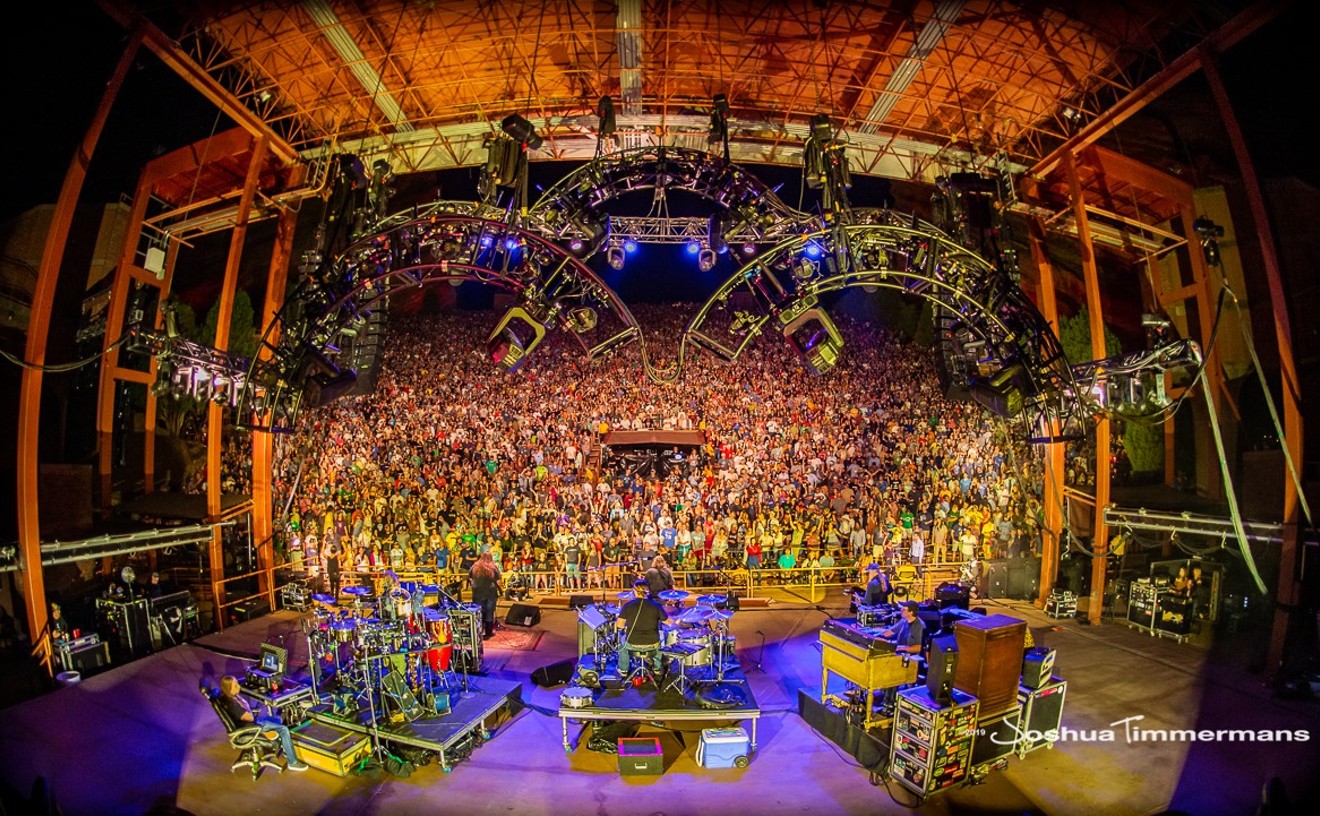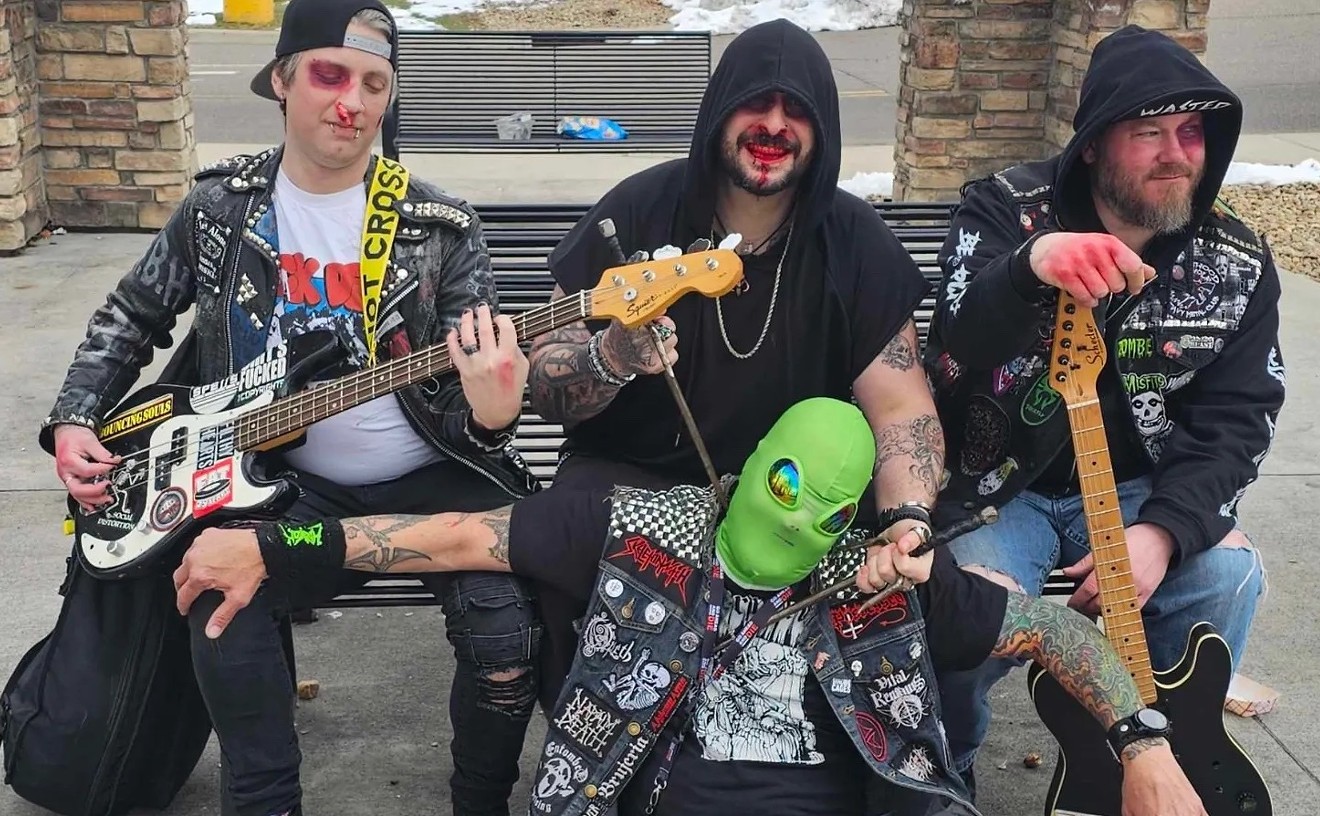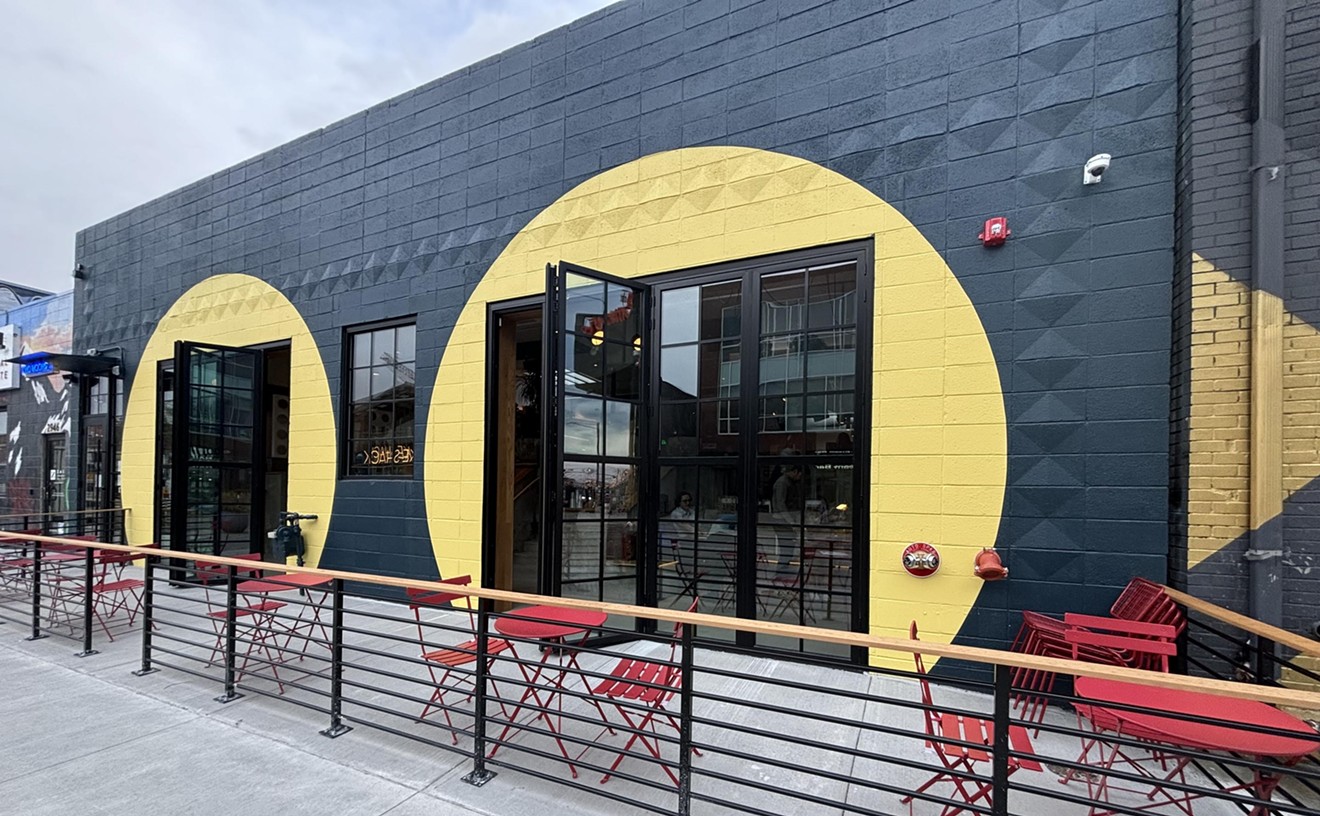"I don't think we have any aspirations," says percussionist Jeffree Lerner. "We're just following our hearts, continuing to grow as people and as musicians -- no real goals for where we want to go."
"We feel that a new understanding of vibration could usher in the next evolutionary step for this planet," reads the band's press kit, which feels more like a manifesto, complete with sayings such as "Time is art," "You are love," "Peace is now" and symbols appropriated from exotic religions. The bio states: "New forms of art, technology, agriculture, medicine, architecture and design, and a higher collective consciousness may all be realized through vibration and music."
You can almost smell the patchouli, can't you?
STS9 continues to broadcast this nouveau-hippie worldview on its latest release, Offered Schematics Suggesting Peace, the group's third full-length on Atlanta's Landslide Records. The album abounds in (mostly) live dance-oriented music that's marked by loose, skittery drumming reminiscent of free jazz. Swirly, purring flute (courtesy of Kofi Burbridge), muted guitar, keyboard and enthusiastic djembe and tabla accents all contribute to the electro-noodling whole. It's the kind of music you hear in the background while shopping for crystals or seeing and being seen at small urban sanctuaries such as private homes that have been opened up for a public poetry reading or a sitar recital. It's green-tea-and-incense music that has a lot to say but doesn't feel the need to scream to make its point.
With all this talk of vibrations and agriculture and stuff, you might be wondering what the point is, already.
"We definitely have our internal standards of how we want to present ourselves," says the soft-spoken Lerner. "We love being part of concert events like the Earth Day Festival. It was a real holistic event. Leonard Peltier's sister was there, the Dalai Lama's assistant was there -- powerful people. It's more than just going to see bands. It's about what's going on in the world. It's kind of what we want to get into, as well: being part of a greater consciousness, playing a musical role in a larger event. I think it's a collective path that comes from wanting to offer that space through music."
The players -- Lerner, Hunter Brown (guitar), David Murphy (bass), David Phipps (keyboard) and Zach Velmer (drums) -- strive to create a holistic live experience by incorporating lights, screened projections and improvisational art into the show, as well as providing a forum for local artists at the gigs. The purpose, as articulated in the song "Baraka" (from Offered Schematics), is to help everyone who participates "find something special in this short journey together." Says Murphy, "We really feel like the music we play is everyone's music. It's not our music. We don't play it; it's everyone in that room making the music."
The community experience doesn't stop there. According to the group's Web site (sts9.com), anyone can add to the experience by contributing to the "Time Is Art" capsule at one of Sound Tribe's three shows in Denver and Boulder next week. "Bring small items such as crystals, trinkets, poems, prayers, intentions, art, photos to be placed in the capsule every night," the page reads. "Share the love and creativity." (If you're sharing the love and creativity with everyone there, including the musicians, do you get a cut of the door, too?) If any STS9 fans -- also known as "Vibrationists" -- are unable to contribute to the experience in person during one of the band's live appearances, it is still possible to contribute on the Web. The "Communication Lowdown" is a "a free spirited place to express your intentions and address topics that propel our state of existence to a higher sense of enlightenment." There, aspiring bards contribute haikus and poems with titles like "extra cranium capacity" and "JA TRUTH ZEN GRAPHIC ART IS HERENOW OM.:." and post them amid other pieces that often appear to have been written in a winter-chilled VW van with tie-dyed curtains.
"The name is a crucial thing, in the sense that we are a sound tribe, beyond the five musicians that are involved in presenting the music," says Lerner. "There are so many people involved in what we're able to bring. There is no star musician, no one [person] in the spotlight. It's really a group thing." The STS9 team includes a gang of ten crew members, including a sound engineer/massage therapist and a supplier of crystal mandalas. While there is no hydroponics expert or candle roadie on staff, there is an artisan who crafts custom-made hemp tickets to each show, which are later put up for sale on the band's Web site.
All communal experiences have to start somewhere, and this one started in Atlanta in 1996, when Velmer, Murphy and Brown started playing together. A year later, they recruited Phipps during a benefit at a local community center. Playing under the name El Buho and the Ultimate Acid Jazz Experience, the band was soon presented to Southern audiences by trumpeter Gary Gazaway, who has worked with both Phish and Bob Marley. The group's first studio album, Interplanetary Escape Vehicle, followed in 1999 under the Sound Tribe handle; today it sounds like little more than a rough preview of the kind of music the band would go on to refine through its live performances. Chock-full of instrumental, funky folk and jazz jams, Escape Vehicle nonetheless caught the ear of local DJ Jeff Dunham soon after its release. The jock's support of the band helped it begin to cultivate a solid regional following.
Musically, though, the combo didn't really jell until Lerner came aboard. His presence is what sparked the band's current interest in multi-layered, multi-culti jams, which are reportedly inspired by Mayan mysticism. (In fact, the group gets its name from the ninth phase of the Mayan calendar, called the Ninth Baktun, which is seen as the height of Mayan civilization.) From this point, the group explores the different textures created by group improvisation, which has been described as "a complex five-way discussion driven in many directions." Call it "trancendentalism."
It's appropriate that two of STS9's three records are live efforts, given that the band's reputation has been built largely on the strength of live shows. Endless touring is the modus operandi for a new breed of electro-jam bands like Sound Tribe, the Disco Biscuits and Deep Banana Blackout, who prefer the stage to the studio -- the kind of group "you've just gotta see live to understand." As a result, if someone's initial exposure to any of these groups is through a recording, the experience is likely to be a little underwhelming. No matter. In cities across America, the band has helped fill a void in the lives of those desperately searching for the next Grateful Phish as well as those who like their electronic music grounded with a more organic sound.
Fittingly, the collective relocated last year from Atlanta to San Francisco and Santa Cruz, where so many dreadlocked, Trustafarian flower children and free thinkers flock to escape. It's in granola-esque enclaves such as these, where everything is just a little bit removed from reality, that bands like STS9 find their niches. The disaffected Adbusters and Greenpeacers need a soundtrack, and Sound Tribe's complicated, trancelike music fits the bill. Recent Bay Area gigs have seen the band sporting glittery, fluorescent face masks and face-painting and adorning the stage with runes, Mayan symbols and multicolored pinwheels to accent the geometric projections swirling around the room.
But, as the band itself says, time is art. And time rolls on, which often means that change is afoot.
"We're working on releasing some more live music that's more electronic," says Lanfree. Indeed, Sound Tribe has been branching out into more computerized realms, gigging under the pseudonym Tzolkin, so Vibrationists should expect the next record to be more of an electronic studio effort. Whatever the band does, it's probably safe to say that the essential, experiential goal of STS9's music will remain intact, much to the delight of its loving, blissed-out followers.










